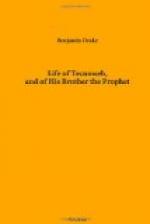“Upon the return of the volunteers from the pursuit, King proposed to Sam Davidson, his friend and relative, and to other comrades, to go round with him by the spot where he had killed the Indian, because he wanted to get his fine leggins. They had noticed a particular tree and a log, near to which the Indian fell. They found the tree without difficulty, but the body was not discovered quite so readily; but King insisted that it must be somewhere thereabouts. Sam Davidson first discovered it. It was lying behind a tree, face downward. ’Here he is,’ said Davidson, ‘but I see no wound upon him.’ ‘Roll him over,’ said King, ’and if it is my Indian, you will find two bullet holes in his left breast.’ It was done; and there were the two bullet holes, an inch apart, just below the left pap—the same, no doubt, where King’s balls had entered. The Indian, from his dress, was evidently a chief. His fanciful leggins, (King’s main object in hunting out the body,) his party-colored worsted sash, his pistols, his two dirks, all his dress and equipments, were the undisputed spoils of King. He kept one of the dirks, the sash, and moccasins for himself; the rest he distributed as presents among his messmates.
“Now, it was this very Indian, which was afterwards identified by those who had known him, as TECUMSEH—this and no other.”
This testimony, coming as it does from a highly respectable quarter, would seem to be conclusive in favor of the claim of King. It contains, however, statements which, if true, greatly weaken its force; and, indeed, in our opinion, dissipate at once the idea that the Indian killed by King was Tecumseh. The narrative states that “the Indian, from his dress, was evidently a chief. His fanciful leggins, his party-colored worsted sash, his pistols, his two dirks, all his dress and equipments, were the undisputed spoils of King.” Now, if there be any one fact connected with the fall of Tecumseh which is fully and fairly established upon unimpeachable authority, it is, that he entered the battle of the Thames, dressed in the ordinary deerskin garb of his tribe. There was nothing in his clothes, arms or ornaments, indicating him to have been a chief. On this point the testimony of Anthony Shane is explicit; and his statement is confirmed by colonel Baubee of the British army, who was familiarly acquainted with Tecumseh. This officer, the morning after the action, stated to one of the aids of general Harrison, that he saw Tecumseh just before the battle commenced, and that he was clothed in his usual plain deer-skin dress, and in that garb took his position in the Indian line, where he heroically met his fate. The testimony in favor of Mr. King’s claim, while it proves very satisfactorily that he killed an Indian, is equally conclusive, we think, in establishing the fact that that Indian was not the renowned Tecumseh.
With the statement of one other person, upon this vexed question, we shall take our final leave of it. Major William Oliver, of Cincinnati, in a communication to the author, under date of 23d December, 1840, says:—




